Nakoa: the revolution of aged fish challenging Cagliari’s culinary tradition | Olianas
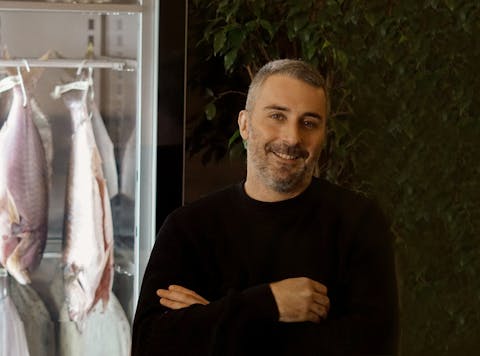
People
Nakoa: the revolution of aged fish challenging Cagliari’s culinary tradition
by Jessica Cani
In Cagliari’s culinary scene, where the idea of “ultra-fresh fish” is almost sacred, Luca Marini is leading a small culinary revolution through his restaurant Nakoa. An ambitious challenge born from his international experience and the desire to bring innovation to a city deeply rooted in maritime traditions.
Born in 1987, Luca Marini shaped his experience through a culinary journey across three continents. Starting in London after graduation, he quickly rose through the ranks to become sous chef at Zafferano, the first Michelin-starred Italian restaurant in the British capital, led by chef Giorgio Locatelli. His journey then took him to Montenegro and later to Australia, where between Sydney and Melbourne he absorbed some of the most innovative influences in global cuisine.
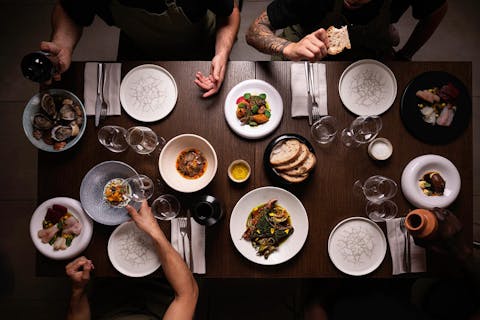
Marini’s return to Sardinia in 2016 marked a significant turning point: the transition from chef to executive chef of a major restaurant group in Cagliari. This shift highlighted the line between culinary artistry and business management. As executive chef, Marini had to orchestrate a complex symphony of ten venues, each with its own identity and needs. It was no longer just about creating dishes, but managing budgets, food costs, staff training, and menu development, all aligned with specific market demands.
Creativity becomes horizontal. While a head chef can focus on expressing their culinary vision, an executive chef must balance creativity with commercial needs, developing different concepts for different venues while remaining within predetermined economic parameters. It is a balancing act between culinary passion and business pragmatism.
This six-year experience proved invaluable but ultimately limiting for someone like Marini, who felt the call of creative cuisine. This personal tension between management and creativity drove him to the dream of opening his own restaurant, where he could finally express his gastronomic vision without compromise.
By May 2024, Nakoa was born.
The restaurant embodies Marini’s philosophy: an intimate and welcoming space, featuring a large window that allows the kitchen to be seen from the street—a symbol of transparency that goes beyond architecture. The gastronomic offering is not limited to a single culinary style but encompasses all of the chef’s experiences, creating dishes that follow the rhythm of the seasons and the inspiration of the moment.
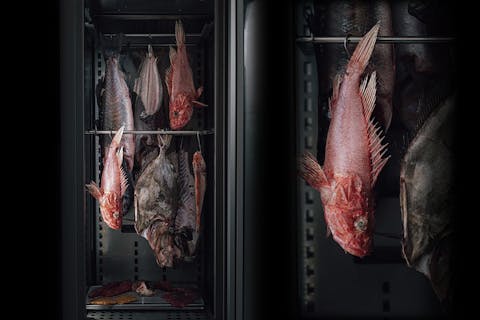
What we now call gastronomic innovation is often nothing more than a conscious rediscovery of ancient wisdom. The dry aging of fish, which is revolutionizing contemporary cuisine, is in reality a return to the roots, a reconciliation with ancestral practices that progress had temporarily overshadowed.
For Luca Marini, it is a kind of revolution rooted in tradition. At Nakoa, his intimate restaurant, fish dry aging is not just a technique—it becomes a manifesto of a culinary philosophy that unites past and future.
“Fresh fish is not necessarily the best,” Marini states with the confidence of someone who has studied the subject deeply. A declaration that may sound heretical in a seaside city like Cagliari, but it contains a profound historical truth. Before modern refrigeration, coastal communities had developed sophisticated fish maturation techniques—practices that Marini is now reviving and perfecting with scientific precision.
In Nakoa’s temperature- and humidity-controlled chambers, the ancient practice of dry aging meets modern technology. “It is a process that requires patience and precision,” explains the chef while monitoring the pH of the aging fish. Each fish is treated differently, with aging times ranging from 5 to 30 days depending on size and type.
Marini’s approach goes beyond preservation. It is a continuous search for excellence, where every step of the process is designed to maximize the organoleptic qualities of the fish. Delicate scaling with a knife, careful gutting, constant humidity monitoring—every gesture is calibrated for optimal results.
In Marini’s kitchen, dry aging becomes part of a broader sustainability approach: at Nakoa, every part of the fish is used, from heads to collars, in a menu that celebrates the ingredient in its entirety. “It’s not just about taste,” he emphasizes, “but about respect for the product and the sea.”
His cuisine thus becomes a bridge between eras. On one hand, it recovers the ancient wisdom of natural preservation; on the other, it employs the precision of modern technology to ensure extremely high quality standards. The result is a truly unique gastronomic offering, where fish develop deep and unexpected flavors. “A grouper, for example,” Marini explains, “develops a silky tenderness with almost almond-like notes. The fish skin, once grilled, acquires a crispness reminiscent of pork rind. Tuna belly, after thirty days, achieves a complexity of flavors comparable to a high-quality red meat.”
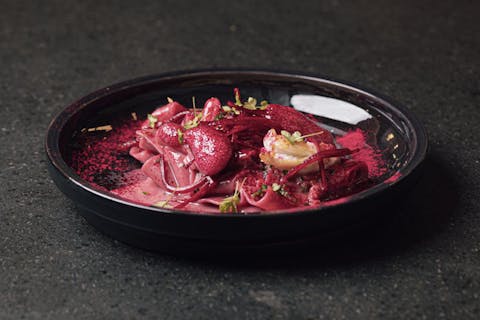
It is fascinating to think that, in an age of speed and immediacy, we are rediscovering the value of patience. Dry aging teaches us that time is not the enemy of food, but a fundamental ingredient in its transformation. This return to the origins is not nostalgia, but conscious progress. It is the understanding that tradition is not a constraint of the past, but a bridge to the future. In his restaurant, Marini demonstrates how ancient wisdom, when combined with modern precision, can open new gastronomic horizons. Dry aging thus becomes a symbol of a cuisine that looks to the future while honoring its roots, innovating with respect for tradition.
In an era where sustainability has become imperative, these ancient practices remind us that our ancestors had already found elegant solutions to problems that today seem insurmountable. Dry aging not only enhances the flavor of the fish, but also allows for longer preservation without industrial processes, reducing waste and maximizing the use of every part of the catch.
In his restaurant, Marini is educating customers to a new awareness of taste. His approach is not a challenge to tradition, but a natural evolution of seafood cuisine. Through his work, he demonstrates how ancient preservation techniques, when combined with modern understanding of maturation processes, can open new frontiers of flavor.
Obsessed as we are with speed and immediacy, Marini’s work reminds us of the value of patience. Dry aging becomes a metaphor for a cuisine that takes its time, respecting the natural rhythms of the ingredients.
This is Luca Marini’s true revolution: transforming an ancient preservation practice into contemporary art, creating a cuisine that is not only objectively delicious, but profoundly respectful of the raw ingredients and their origins. A cuisine that looks to the future without forgetting the lessons of the past.
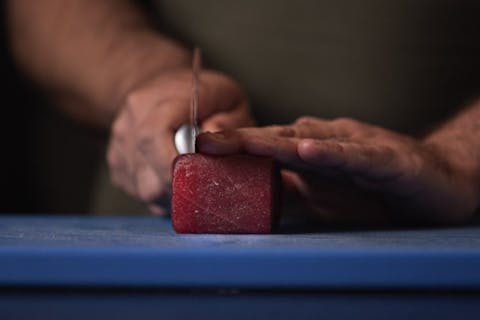
The strength of dry aging lies in its dual nature: a cutting-edge culinary technique and a deeply sustainable practice. At Nakoa, Luca Marini has developed a system that addresses the challenges of contemporary dining.
Sustainability is expressed in three key aspects:
Natural Preservation: “Dry aging allows us to store fish for up to two weeks at positive temperatures, without freezing,” explains Marini. This approach significantly reduces energy consumption and optimizes the management of fish resources.
“Head-to-Tail” Philosophy: Every part of the fish is valued. Collars, heads, and offal, traditionally considered waste, are transformed into high-value culinary dishes. It is not only an ethical choice but also an intelligent management strategy in an era of rising seafood costs.
Consumer Education: Guests learn that often-overlooked parts of the fish can provide surprising gastronomic experiences, fostering broader food awareness. Dry aging thus becomes a symbol of modern dining that combines culinary excellence with environmental responsibility, creating a virtuous and replicable model.
Just as a great wine requires time to develop the complexity of its aromas, dry-aged fish gradually reveals new flavor nuances. “It’s a process of transformation that requires patience and understanding,” explains Marini. “Just as a winemaker monitors the evolution of wine in the cellar, we carefully follow each stage of the fish’s aging, observing how the flavors concentrate and evolve over time.”
In both cases, environmental control is essential: temperature and humidity must be perfectly balanced. And just as each grape variety has its optimal maturation time, each type of fish requires a specific aging period to fully express its characteristics. It’s an art that demands sensitivity and precision, where time becomes an ally in creating a product of excellence.
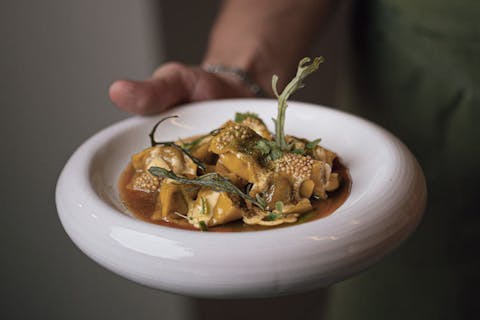
Beyond the ever-present raw dishes, the tagliolino with vanilla butter, raw red prawn, and truffle is one of Marini’s signature classics, carried forward for years. A dish that combines elegance and simplicity, where the sweetness of vanilla butter complements the delicacy of the raw prawn.
The pappardella with scampi and Patanegra lard is another menu staple, a preparation the chef has been serving for a long time and which continues to be highly appreciated by guests.
Special attention is given to the “head-to-tail” section of the menu, a convivial tasting that allows guests to explore dry-aged fish in all its forms: starting with raw preparations, then grilled fish, fried parts, and soups, including liver pâté and other dishes that showcase every part of the catch.
An example of Nakoa’s philosophy is also the fish soup, composed of fish and shellfish (gurnard, scorpionfish, ray, prawns), some dry-aged and some fresh, lightly grilled, served in a concentrated Adriatic broth with potatoes and green sauce.
The offerings are constantly evolving, following the availability of local fish, which represents 90% of the restaurant’s menu. Each dish is designed to highlight the unique characteristics that the dry-aging process imparts to the fish.
When it comes to dining in Cagliari, Luca Marini offers two recommendations for places that are contributing to the evolution of the city’s gastronomic scene.
Old Friend, by chef Dario Torabi, is an essential reference for Marini. "There’s mutual respect," he explains, emphasizing how Torabi was among the first in Cagliari to have the courage to propose innovative cuisine. The authenticity and creativity of the place make it a must-visit for anyone wanting to explore the best of Cagliari’s dining scene.
For those seeking a more classic yet high-level experience, Marini recommends Retrobanco. Here, traditional cuisine is interpreted with skill and professionalism, in an environment the chef describes as “very French.” The expertise and passion of the owner, Pippo, whom Marini considers not only a colleague but a friend, are reflected in every dish, making the restaurant a reliable choice for a quality gastronomic experience.
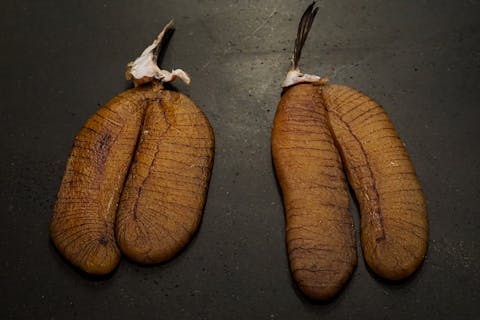
Marini’s goal is clear: to create a culinary journey where the excellence of the ingredients combines with a welcoming and informal atmosphere. Not an austere fine dining experience, but a place of discovery where new flavors harmonize with a relaxed environment, and where dialogue with guests is an integral part of the meal.
The aging of fish was a common practice before the advent of modern refrigeration. Today, thanks to technology and scientific precision, this ancient technique is experiencing a renaissance, allowing forgotten flavors to be rediscovered and opening new frontiers of taste in contemporary gastronomy.
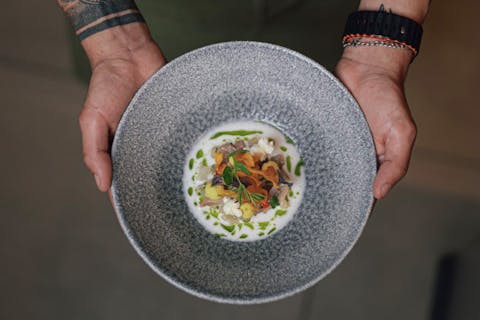
The pictures on this page are courtesy of Gianmarco Garau.
